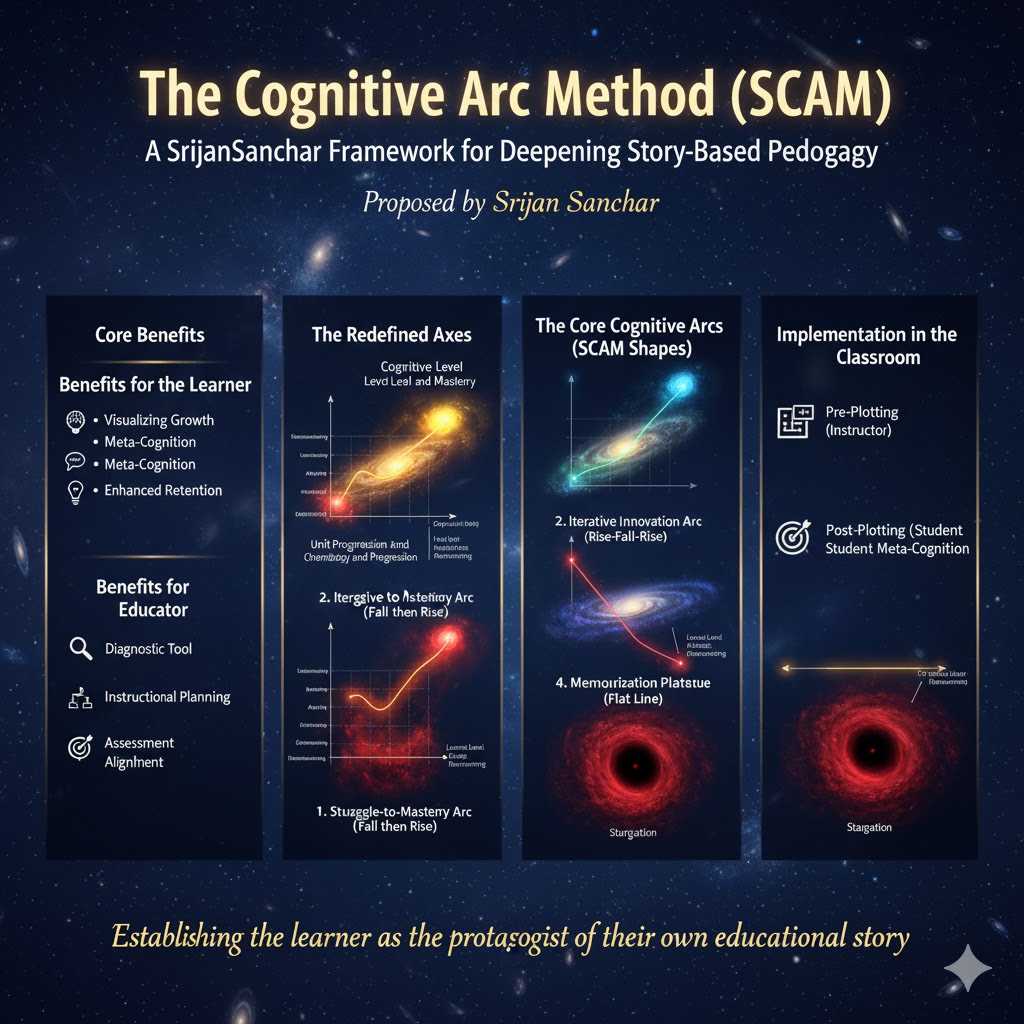Blog Details
- Home
- Blog Details

- Member
- October 27, 2025
The Cognitive Arc Method
The Cognitive
Arc Method
A Srijan Sanchar
Framework for Deepening Story-Based Pedagogy
The Cognitive Arc Mapping Method
(SCAM) is a novel analytical tool that integrates narrative structure with
cognitive science, designed to make the process of deep learning visible,
quantifiable, and emotionally resonant for the student. It reframes the
learning process as a story, charting a learner's cognitive growth along a
dual-axis graph that correlates the progression of a lesson (Time) with the
hierarchy of Bloom's Revised Taxonomy (Cognitive Level).
Section
1: Core Benefits for Learning and Instruction
The Sanchar Cognitive Arc Method
moves Story-Based Pedagogy (SBP) from a tool primarily for engagement to a
powerful instrument for meta-cognition and instructional analysis.
Benefits
for the Learner
- Visualizing Growth:
It externalizes the abstract process of thinking, demonstrating that
frustration and failure (the "dip" in the plot) are natural,
necessary steps toward mastery, thereby promoting a Growth Mindset.
- Meta-Cognition:
Students are required to plot their own learning arc, consciously
identifying where they were operating at the level of Understanding
versus Analyzing, improving self-assessment skills.
- Enhanced Retention:
By associating cognitive struggles and breakthroughs with memorable
narrative shapes, emotional context is layered onto the learning, which
significantly aids memory and recall.
Benefits
for the Educator
- Diagnostic Tool:
Teachers can instantly identify if the lesson design is successfully
driving students toward Higher-Order Thinking (HOT) skills or if the class
is stagnating at the Memorization Plateau.
- Instructional Planning: The framework encourages intentional instructional
design. Educators must plan specific activities that will act as narrative
"inciting incidents" to push students from one Bloom’s level to
the next (e.g., an "Analyzing" task to follow a foundational
"Understanding" lecture).
- Assessment Alignment:
The Y-axis provides a direct scale for aligning assignment weights and
rubric scores with measured cognitive achievement.
Section
2: The Redefined Axes
The foundation of SCAM lies in its
re-purposed dual-axis graph. This structure moves beyond simple plot analysis
to map the learner's journey through cognitive complexity.
The
X-Axis: Chronology and Progression
- Definition:
The horizontal axis represents the temporal and structural progression
of the learning journey.
- Scale:
Begins at "Initial Exposure/Unit Start" and ends at "Final
Outcome/Project Completion."
- Function:
It anchors the learning events in time, allowing discrete instructional
moments (e.g., Lecture 1, Group Critique, Final Draft) to be placed
sequentially.
The
Y-Axis: Cognitive Level and Mastery
- Definition:
The vertical axis represents the quality and complexity of cognitive
engagement, directly scaled to Bloom's Revised Taxonomy.
- Scale (Bottom to Top):
- Lowest Level (Base): Remembering (Rote Knowledge, Memorization)
- Mid-Levels:
Understanding, Applying
- Highest Levels (Peak): Analyzing, Evaluating, Creating (Synthesis)
- Function:
As the plot line moves up the Y-axis, the learner is engaging in
increasingly sophisticated cognitive tasks. A high peak signifies the
successful creation of new knowledge or product.
Section
3: The Core Cognitive Arcs (SCAM Shapes)
By plotting a student's cognitive
level (Y) over the course of a story-based unit (X), distinct, repeatable
learning patterns emerge. These Cognitive Arcs provide a vocabulary for
discussing the effectiveness of a lesson's design.
1.
The Struggle-to-Mastery Arc (Fall then Rise)
- Description:
The learner begins at a basic level (Understanding), experiences a sharp
fall due to a challenging problem requiring Analysis (the
"struggle"), and then climbs to a new high, achieving Evaluation
or Creation.
- Meaning in SBP:
This arc is ideal. It validates the SBP principle that genuine cognitive
growth requires confronting meaningful conflict (the plot's crisis point)
and moving past initial difficulty.
2.
The Iterative Innovation Arc (Rise-Fall-Rise)
- Description:
A quick rise (initial success in Understanding), a significant drop
(the "midnight" of the plot, representing failed application or
harsh critique), and a final, permanent rise to a high level of Creating.
- Meaning in SBP:
This represents effective feedback loops and revision. It
teaches that the first attempt is rarely the best, and true mastery is
achieved through acknowledging setbacks and applying learning from
failure.
3.
The Consequential Decline Arc (Steady Fall)
- Description:
The learner begins at a seemingly proficient level (Applying), but as the
story/problem requires Analysis of complex, multi-variable issues,
the plot line declines steadily toward Confusion (near the
baseline).
- Meaning in SBP:
A warning sign for both the student and the instructor. It represents
either a foundational misunderstanding that was never addressed, or a
failure to adapt to the rising cognitive demand of the narrative.
4.
The Memorization Plateau (Flat Line)
- Description:
The plot remains largely horizontal, hovering around the Remembering
and Understanding levels.
- Meaning in SBP:
Indicates that while the unit content may have been delivered, no
intellectual "plot points" were introduced to challenge the
learner into Analysis or Creating. The learner consumed the
information but failed to engage in deep, transformative thought.
Section
4: Implementation in the Classroom
SCAM can be implemented at the
beginning and end of any SBP unit:
- Pre-Plotting (Instructor): The instructor uses the model to design the lesson,
strategically placing "Inciting Incidents" (challenges) on the
X-axis that demand a vertical shift in thinking (Y-axis).
- Post-Plotting (Student Meta-Cognition): After the unit, students are asked to plot their own arc,
marking where they felt frustrated (a fall), where they found an answer (a
rise), and what Bloom’s level they believe they achieved at the climax
(the peak).
This final act of reflective
charting closes the loop, establishing the learner as the protagonist of
their own educational story.
